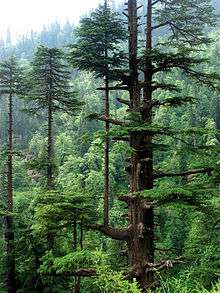Temperate coniferous forest
Temperate coniferous forest is a terrestrial habitat type defined by the World Wide Fund for Nature. Temperate coniferous forests are found predominantly in areas with warm summers and cool winters, and vary in their kinds of plant life. In some, needleleaf trees dominate, while others are home primarily to broadleaf evergreen trees or a mix of both tree types.[1] A separate habitat type, the tropical coniferous forests, occurs in more tropical climates.

Temperate coniferous forests are common in the coastal areas of regions that have mild winters and heavy rainfall, or inland in drier climates or montane areas. Many species of trees inhabit these forests including pine, cedar, fir, and redwood. The understory also contains a wide variety of herbaceous and shrub species. Temperate coniferous forests sustain the highest levels of biomass in any terrestrial ecosystem and are notable for trees of massive proportions in temperate rainforest regions.[1]
Structurally, these forests are rather simple, consisting of 2 layers generally: an overstory and understory. However, some forests may support a layer of shrubs. Pine forests support an herbaceous groundlayer that may be dominated by grasses and forbs that lend themselves to ecologically important wildfires. In contrast, the moist conditions found in temperate rain forests favor the dominance by ferns and some forbs.[1]

Forest communities dominated by huge trees (e.g., giant sequoia, Sequoiadendron gigantea; redwood, Sequoia sempervirens; mountain ash, Eucalyptus regnans), an unusual ecological phenomena, occur in western North America, southwestern South America, as well as in the Australasian region in such areas as southeastern Australia and northern New Zealand.[1]
The Klamath-Siskiyou ecoregion of western North America harbors diverse and unusual assemblages and displays notable endemism for a number of plant and animal taxa.[1][2]
Ecoregions
Eurasia

Indomalayan temperate coniferous forests | |
|---|---|
| Eastern Himalayan subalpine conifer forests | Bhutan, India, Nepal |
| Western Himalayan subalpine conifer forests | India, Nepal, Pakistan |
North America
| Nearctic temperate coniferous forests | |
|---|---|
| Alberta Mountain forests | Canada |
| Alberta-British Columbia foothills forests | Canada |
| Arizona Mountains forests | United States |
| Atlantic coastal pine barrens | United States |
| Blue Mountains forests | United States |
| British Columbia mainland coastal forests | Canada, United States |
| Cascade Mountains leeward forests | Canada, United States |
| Central and Southern Cascades forests | United States |
| Central British Columbia Mountain forests | Canada |
| Central Pacific coastal forests | Canada, United States |
| Colorado Rockies forests | United States |
| Eastern Cascades forests | Canada, United States |
| Fraser Plateau and Basin complex | Canada |
| Florida Scrub | United States |
| Great Basin montane forests | United States |
| Klamath-Siskiyou forests | United States |
| Maritime Coast Range Ponderosa Pine forests | United States |
| Middle Atlantic coastal forests | United States |
| North Central Rockies forests | Canada, United States |
| Northern California coastal forests | United States |
| Northern Pacific coastal forests | Canada, United States |
| Northern transitional alpine forests | Canada |
| Okanogan dry forests | Canada, United States |
| Piney Woods forests | United States |
| Puget lowland forests | Canada, United States |
| Haida Gwaii | Canada |
| Sierra Nevada forests | United States |
| South Central Rockies forests | United States |
| Southeastern conifer forests | United States |
| Wasatch and Uinta montane forests | United States |
| Sierra de Manantlán Biosphere Reserve[3] | Mexico |
| Monarch Butterfly Biosphere Reserve | Mexico |
South America
Neotropical temperate coniferous forests | |
|---|---|
| Araucaria montane forests | Argentina, Chile |
| Austrocedrus forests | Argentina, Chile |
| Fitzroya forests | Argentina, Chile |
| Araucaria moist forests | Brazil, Argentina |
References
-

- Kauffmann, Michael (2012). Conifer Country. Kneeland: Backcountry Press. ISBN 978-0-578-09416-8.
- https://www.biodiversidad.gob.mx/ecosistemas/bosqueTemplado.html
- Waring, Richard H (2002). "Temperate coniferous forest" (PDF). Volume 2, The Earth system: biological and ecological dimensions of global environmental change. Chichester: John Wiley & Sons, Ltd. pp. 560–565. Retrieved April 18, 2012.
